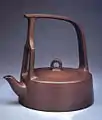Gu Jingzhou
Gu Jingzhou simplified Chinese: 顾景舟; traditional Chinese: 顧景舟; pinyin: Gù Jǐngzhōu (18 October 1915 in Yixing, Jiangsu – 3 June 1996) was a Chinese ceramic artist who specialised in the creation of zisha-ware teapots. He was a founder and Deputy Director of Research and Technology at the Number One Yixing Factory.
Gu lived in Yixing, a city noted for its pottery. In his early career he worked for an antique dealer named Lang Yushu, and it was during this time that he was exposed to many pieces of classical zisha (purple clay) pottery, a style which he emulated in his own work. He wrote and researched the topic of zisha-ware extensively, and was granted the title "Master of Chinese Industrial Art".[1]
Works by Gu are highly valued, and sell for as much as $2 million.[2]
Literature
References
- Chunfang Pan (2004). Yixing Pottery: The World of Chinese Tea Culture. Long River Press. p. 28. ISBN 978-1-59265-018-7.
- Chen, Louise. "How a Chinese Teapot Fetched $2 Million". Art Info. Blouin. Retrieved 11 May 2016.
Gallery
|
Legend has it that the Gong Chun teapot, today at the National Museum of China, was made by a monk's servant at the Jinsha temple in Yixing. Its flattened spherical shape with its irregular surface imitates a tree canker. |
|
The body of the Water caltrop teapot consists of six equal sections whose design was inspired by the Water caltrop (Trapa bispinosa, (Chinese: 菱; pinyin: líng). Its edges are perfectly balanced. The veins of the leaves converge to the centre, the bottom slightly caves in. |
|
The Chinese francolin-High Beam teapot (Chinese: 鹧鸪提梁壶) got its name from a Southasian pheasant-like bird. Its handle, which connects to the body raises high above its short, cylindrical body. |
|
This teapot made of red Yixing clay was created for the National Craftspeople Conference, and combines several traditional features of Yixing clay teapots. |
|
The Cloud collar-Ruyi teapot got its name from the traditional patterns of the "cloud collar" and the Ruyi scepter, symbols of good luck. The design of the pot is simple and traditional. The cloud collar rests on the "shoulders" of the body. The knob of the lid has the shape of a lotos blossom. |
|
All sections of this tea pot are hexagonal in shape. Its body is spherical and slightly flattened. The rectangular and round elements fit together harmonically, creating an overall impression of boldness. |
|
The Rain-Dew-Stars-High Beam teapot combines straight and curved lines, whose turning points are pure and flowing. The boldness of the lower part balances the dynamics of the upper section. |
|
The Well brim teapot is slightly curved, the walls of its body converge as they move upwards. The balance point of the handle is slightly offset. |
|
The body of the Bamboo teapot has been given the shape of an old bamboo stem, the spout represents a new shoot sprouting from the old stalk. |









